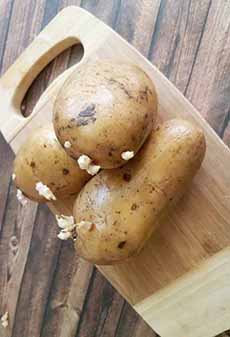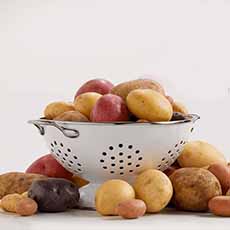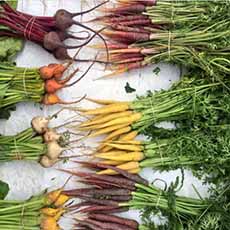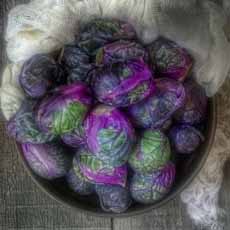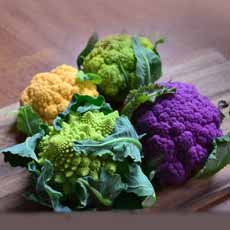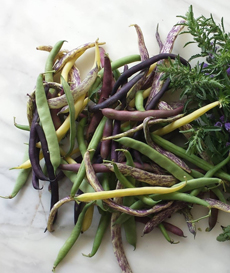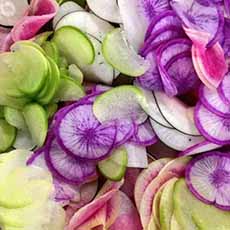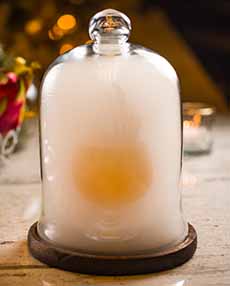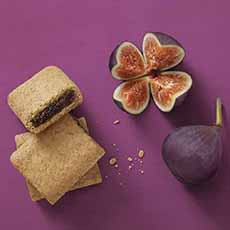|
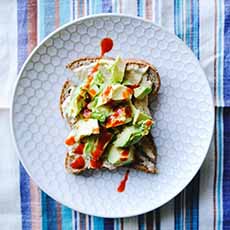
[1] Avocado toast and hummus with hot sauce (photo © Hope Hummus).
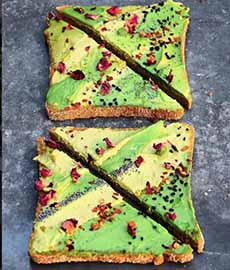
[2] “Three Shades Of Avocado Toast,” avocado, hummus and tahini (photo Food Deco | Instagram).

[3] For a special occasion: lobster avocado toast (photo © Ocean Prime Restaurant).
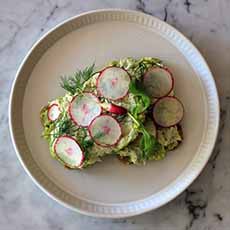
[4] Avocado toast with deviled hamachi collar (substitute smoked fish) and sliced radishes (photo © Kindred Restaurant | Davidson, North Carolina).
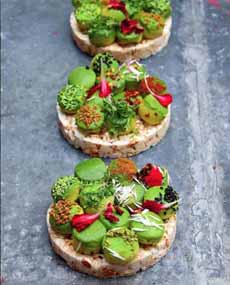
[5] Scooped balls of avocado (use a melon baller) on a rice cracker, with broccoli florets, beet microgreens and spices (photo Food Deco | Instagram)
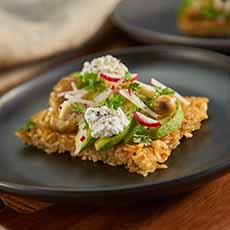
[6] Another rice base: This recipe uses a rectangle of brown rice instead (photo © Think Rice).
|
|
Avocado toast first appeared on menus nationwide at hip coffee shop with Millennial clientele.
From there, it began to replace breakfast and lunch choices among other demographics.
Last weekend, we attended a birthday brunch at a restaurant. The honoree and all of her grandmother friends ordered…avocado toast, topped with a fried egg.
The rest of us ordered the Chicken & Waffles, Eggs Benedict and Tuna Niçoise.
In fact, since the first mashed avocado appeared on whole grain toast, the [recip3e] itself has been expanded. Here’s some of what you can find in restaurants nationwide—and make for yourself at home.
Thanks to Flavor & The Menu for the original article.
ENHANCED AVOCADO TOAST
To start, you can slice the avocado or mash it. You can use your choice of bread, from crusty rustic to multigrain, rice crackers to…bagels.
Check out photo #5, which uses rice crackers instead of bread, and photo #6, which substitutes crispy squares of pan-fried brown rice for the toast (here’s the recipe).
You can choose from a buffet of garnishes:
Crumbled Cheese: blue, feta, goat, parmesan/asiago, queso fresco
Fancy: crab, lobster (photo #3), shrimp
Greens: baby arugula, mesclun, microgreens, sprouts
Herbs: basil, chives, cilantro, dill, oregano, thyme
Pesto: particularly sundried tomato pesto
Pickled: carrots, chiles, gherkins, onions, mushrooms, and any other pickled vegetables
Nuts: chopped pistachios, sliced almonds or other toasted nuts
Onions: pickled, red, scallions, sweet
Seeds: chia, flax, pomegranate, pumpkin, sunflower, toasted sesame
Smoked Fish: herring, salmon, sturgeon, whitefish
Spices: chile flakes, curry, paprika
Spicy/Peppery: chiles, horseradish, hot sauce, radish, watercress
Plus: hummus (photos #1 and #2), lemon or lime zest, flavored EVOO drizzle
From there, consider these directions:
1. PUT AN EGG ON IT
Perhaps the first enhancement to a slice of avocado toast was an egg: boiled, hard boiled and sliced, fried, poached or scrambled. It adds protein, and lets the topped toast transition to brunch or lunch.
For a special occasion, consider duck or quail eggs.
2. GO MEDITERRANEAN
Avocado blends beautifully with Mediterranean flavors Alternate or layer mashed avocado with hummus
Add some local cheese: crumbled feta or grilled halloumi, for example. Maybe even a honey drizzle?
For accents: dukkah, harissa, lemon zest, sumac, tahini drizzle, za’atar.
3. ADD SOME “CREAMY”
Top the avocado with something creamy: crème fraîche, Greek yogurt, sour cream.
To that, you can add crumbled cheese (see the list above).
For an extra touch, add a favorite flavor to the yogurt or sour cream: curry, dill, garlic.
Or blend it with basil or sundried tomato pesto. For the holiday season, add some pumpkin purée.
4. VEGGIE TIME (FRUITS, TOO!)
Top the vegetable (avocado) with more vegetables—whatever you like. chefs are looking to avocado toast as a fitting platform. The sky’s the limit, where the build out can simply star a bevy of fresh produce or can star complex and intriguing flavors and textures—all pulled from the veg-centric universe.
Fresh vegetables: cherry tomatoes; scallions; shaved broccoli stems, carrots and fennel, cauliflower florets.
Grilled vegetables: any assortment.
Marinated and pickled vegetables: carrots, onions/scallions, mushrooms, pimento, sundried tomatoes
You can pickle just about any vegetable. Asparagus, baby corn, beets, carrots, green beans (“dilly beans”), mushrooms, okra, pearl onions, sliced onions, snap peas, tomatoes and turnips, for example.
Pickled fruits also enhance avocado: apples, Asian vegetables (bean sprouts, bok choy, etc.), pears, rhubarb and stone fruits (cherries, nectarines, peaches, plums).
Here’s how to make 2-hour pickled fruits and vegetables.
MORE AVOCADO TOAST (AND FRIENDS OF AVOCADO TOAST) RECIPES
Avocado & Sour Cream Toast
Loaded Avocado Toast Or Crostini
Mashed (Or Smashed) Pea Toast
Sweet Potato Toast
|
THE HISTORY OF AVOCADO TOAST
Although a relatively new trend in the U.S. (we first noticed it about six years ago), avocado toast has been “commonplace for a long time,” according to Wikipedia.
In Australia and Chile, large avocado growers, people have been eating avocado toast for decades.
In the U.K., it has been a popular snack since the early-1970s.
In Mexico, where the avocado is indigenous (the history of avocado), avocado on corn tortillas dates to ancient times.
Surely, some conquistador, or more likely one of the nuns who followed in the early 16th century (the nuns created fusion European-Aztec cuisine, adapting New World ingredients to Old World cooking styles), first put sliced avocado on a piece of toasted European bread. But the record is mute on that.
According to an article in The Washington Post, chef Bill Granger of Sydney, Australia may have been the first person to put avocado toast on a menu, in 1993. Another Australian chef believes that the combination of avocado and toast emerged in Queensland, Australia in the mid-1970s.
Now, Millennials call it “smashed avo.”
In 1999, Nigel Slater published a recipe for an avocado “bruschetta” in London’s newspaper, The Guardian.
Even earlier, in 1962, a New York Times article showcased an “unusual” sandwich of avocado on toast.
And even earlier than that, in 1937, The New Yorker published an article, “Avocado, or the Future of Eating,” in which the protagonist eats “avocado sandwich on whole wheat and a lime rickey.” [source]
But credit social media with launching this low-key breakfast and snack into stardom, with an endless number of photos making it a must-have for avocado lovers.
|







